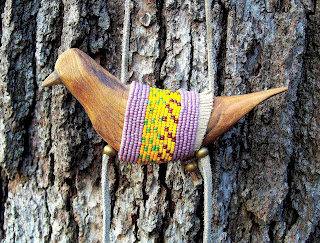Copyright Lance
Kinseth, Bird Totem, 3”hx6w,
wood/beads—maize patterns/leather/brass, 1990
SACRED: To regard
with reverence and awe—every experience; not when we decide to certify
something as “special” or “divine” or “holy” or the subject of devotion.
Sacredness is inclusive and commonplace rather than
exclusive to some events and not others.
Water and grasses and trees and people are inherently “holy” and
miraculous, simply in their presence, in their being-ness,
just-as-they-are. When sacredness
appears to be rare, it is an expression of our limits.
Sacredness involves the experience of reverence and
awe. Each of us might find some
events more appealing than others, but, again, this is our limit. The most seemingly irreligious event is
graced and miraculous. Even our
work and garbage/waste and tasks that we find distasteful and boring and
occurrences that we find negative have sacredness in, for example, what they
offer us, teach us and how that process may potentially strengthen us.
The authentically sacred is real and concrete, in all form
and force, rather than something esoteric and distanced. Rather than overlook, perhaps gaze at the most obscure object—a chair, a painted wall,
a light bulb, a brick, a corn flake, and a pencil—and begin to acknowledge—by
slowly tracing back—the millions of natural events and tweaking of human
designs that brought it to fruition.
Our most rational scientific measures all still sing
“mystery” to us. The more we look
and the more we seem to understand, the less we subsume. The “dark energy” that may form the
largest component of the cosmos is still not described. And when described, it will likely not
bring clarity. Vastness and
smallness open to infinities rather than end points. And at any magnitude, we encounter an eloquence and
complexity that triggers awe and reverence. And while events are mysterious, they are concrete.
Copyright Lance
Kinseth, 2012
The everyday that can seem dull is nothing but magic,
miracle. Today I spend some time
with the venerable oak that stands guard over the house. Just this. Its bark expresses the miracle of fractals, seemingly
chaotic yet patterned, that run the everyday world. The oak is a living miracle—an expression of complex
hydrology and earthen minerals.
And more, the oak is star-made, magically building mass from
energy. The oak has been contrived
from atoms born in exploding stars.
And as organic macro-molecules, it is an expression of the outer evolution
of a star rather than something separate.
In a very real way, an oak tree would be nearly impossible to imagine if
it was not right in front of us.
And outside the window, right next to the venerable oak, the disprized
“weed” presses upward through a crack.
In this weed, the eloquence of design that capitalizes on soil
disturbance is present. We stake
our very lives on this weed design in corn, soy, and rice—smaller roots and
overproduction of seeds.
When we slow and quiet, as an artist or as a meditation
practitioner or soft body-mind practitioner, or shaman, we have the opportunity
to fall inside a world within this world that may be the world for we have been
searching. In the short flash of
life that we are offered, it is, perhaps, an obligation, and, certainly, an
optimal opportunity, to go inside that which we presume to be next to nothing,
and to open a wall in our thinking.
BODY-MIND PRACTICES that slow and quiet and calm, such as
restorative-yin yoga and tai chi and qigong, can optimize the chance to gaze
into sacredness as an aspect of our everyday life, as a dynamic in which we are
deeply immersed. Mental awareness
is guided toward slowing and surrendering to the body physiology. The everyday chatter begins to
dissipate. We may begin to listen
more than to think. In body-mind
practices, we no longer simply think about or read about the practice, we do
the practice, and the billions-years-old
tested wisdom of the body teaches.
We mentally calm rather than think, and the body relaxes. We find that we are not just a face and
out thoughts, but this body and more.
If we are fortunate to have the time, we may begin to open to the way
that we outspread into the landscape.
And in this calmness, we begin to not overlook and to not dismiss and
disprize. We begin to see grace
and eloquence and harmony that literally buoy us up in the universe. We begin to look with reverence and
awe, and we are the richer for it.
We may begin to discover that the world that we experience is the longer
reach of ourselves, and not simply a stage-set for our lives, as if the world
turned around us.
Body-mind practices are not done to simply acquire a skill
or to bring relaxation into our lives. They have evolved and sustain because we find something
surprising there. We optimize by
being alert to a larger process that overrides the everyday, and then coming
more into harmony with that world overriding our everyday world, and express
it.



